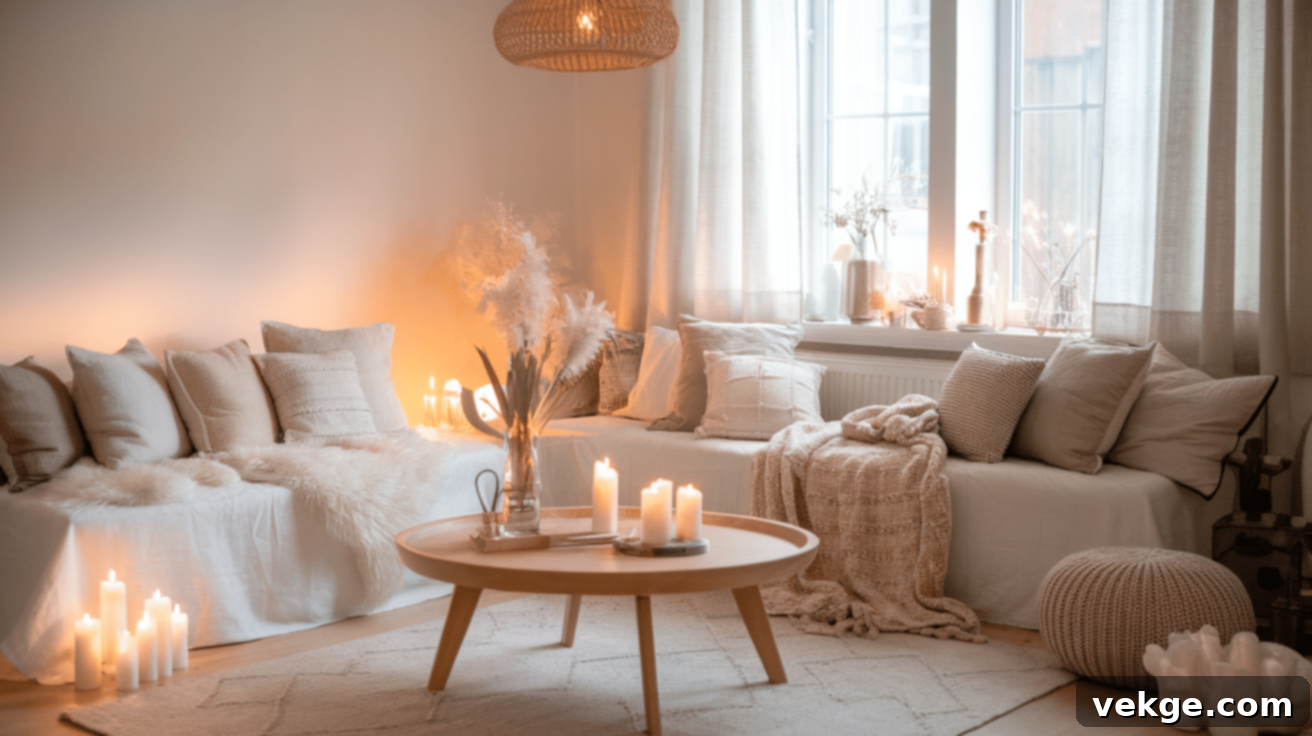Embrace Hygge: Your Ultimate Guide to Creating a Cozy and Comforting Home
The Danish concept of hygge (pronounced “hoo-gah”) offers a deeply comforting and mindful approach to modern living. Far from just a fleeting trend, hygge is a time-honored philosophy centered on creating spaces that foster genuine well-being, warmth, and connection. It’s about more than just aesthetics; it’s about crafting an atmosphere where you feel completely at ease, nurtured, and content within your own home.
This comprehensive guide will walk you through the art of infusing hygge into your personal sanctuary through simple, thoughtful choices. From the soft, flickering glow of candles to the inviting textures of natural materials, hygge isn’t about chasing perfection or fleeting trends. Instead, it’s about cultivating environments that consistently help you feel grounded, relaxed, and happy.
Join us as we explore the fundamental elements that make hygge so uniquely special. Discover how to apply these principles to every room in your home and adapt them through the changing seasons, ensuring your space remains a cozy haven year-round. Get ready to transform your home into a place where comfort and contentment truly thrive.
What Is Hygge Style? Defining Danish Comfort
Hygge style originates from Denmark, a nation consistently ranked among the happiest in the world. At its core, it’s about intentionally designing your home to be a warm, welcoming, and profoundly comfortable refuge. It emphasizes creating an environment where you can feel good, relaxed, and completely at ease.
The concept of hygge in Danish culture traces its roots back to Old Norse, where it meant “protected from the outside world.” Over centuries, the Danes have woven this concept into the very fabric of their daily lives, making it particularly central during the long, dark, and often cold winter months. During these times, creating cozy, inviting indoor spaces isn’t just a preference—it becomes an essential strategy for maintaining well-being and happiness.
At its heart, hygge is built upon several foundational pillars. Firstly, the use of natural materials like wood, wool, cotton, and linen is paramount. These elements bring an organic warmth, texture, and an authentic connection to nature indoors. Secondly, soft, tactile items are crucial; think plush blankets, an abundance of cushions, and soft rugs that invite bare feet to sink in, adding layers of comfort throughout the home.
Lighting also plays an incredibly significant role. Hygge lighting eschews harsh overhead brightness in favor of soft, warm-toned bulbs and, most importantly, countless candles, all contributing to a gentle, ambient glow. Finally, simplicity is a key tenet; hygge encourages a focus on what truly matters, avoiding excessive clutter that can create visual noise and disrupt the peaceful atmosphere.
While hygge shares some superficial similarities with minimalism, they are distinct philosophies. Minimalism often aims to reduce possessions to the absolute bare essentials, prioritizing functionality and a stark aesthetic. Hygge, conversely, focuses on emotional well-being and comfort through the deliberate selection and arrangement of cherished items. Hygge spaces, while simple and uncluttered, are never sparse; they are thoughtfully filled with items that genuinely bring joy, comfort, and a sense of belonging, making them feel lived-in and deeply personal rather than empty or cold.
Key Elements of Hygge Style: Crafting Your Cozy Sanctuary
The distinctive charm of hygge style lies in its unwavering focus on creating spaces that don’t just look good, but fundamentally feel good to inhabit. Let’s delve deeper into the specific elements that combine to make this design philosophy so uniquely inviting and special.
1. Cozy Comfort: The Foundation of Hygge
At the very heart of the hygge aesthetic lies an absolute commitment to comfort. Homes imbued with this style are typically abundant with soft furnishings: plush pillows, warm throws, and inviting blankets are strategically placed around rooms, always within easy reach. Imagine a thick, chunky knit blanket casually draped over a favorite armchair, seemingly waiting for someone to curl up with a good book and a warm drink. Picture several soft, inviting pillows artfully arranged on a couch, transforming it into the perfect spot for an afternoon nap or a relaxed evening conversation.
These items are never merely decorative; they are intended for daily use, actively contributing to the overarching feeling of warmth, security, and tactile pleasure that defines a hygge home. They invite you to slow down, relax, and truly settle in.
2. Natural Materials: Bringing the Outdoors In
Organic elements like wood, wool, linen, and cotton play absolutely pivotal roles in creating authentic hygge spaces. Wooden furniture, for example, brings an undeniable warmth and a vital connection to the natural world indoors. You’ll frequently encounter pieces crafted from pine, oak, or other woods that proudly display their visible grain patterns, celebrating their inherent beauty and character. Wool, revered for its warmth and texture, is incorporated into everything from soft rugs and luxurious blankets to intricate wall hangings. Linen, with its breathable and elegant drape, is favored for curtains, tablecloths, and bedding.
A key aspect of these natural materials is their ability to age gracefully. They often look even better with continued use, developing a beautiful patina that adds to the lived-in, authentic feel that hygge spaces strive for, reflecting stories and memories within the home.
3. Warm Lighting: The Hygge Glow
Perhaps the single most critical element in achieving a truly hygge atmosphere is the careful consideration of lighting. Bright, harsh overhead lights are almost universally avoided. Instead, you’ll discover a multitude of light sources designed to create a soft, inviting glow. This includes an abundance of candles (often unscented to allow natural scents or food aromas to dominate), delicate string lights artfully hung along walls or around windows, and lamps fitted with warm-toned bulbs (think 2700K – 3000K) that cast a gentle yellow light rather than a sterile white one.
The primary goal is to bathe every corner of a room in a soft, diffused warmth, making the entire space feel profoundly welcoming and intimate. Many hygge homes feature multiple, adjustable light sources in each room, allowing the mood and ambiance to be effortlessly tailored to the time of day or specific activity.
4. Neutral Color Palette: Serenity and Calm
The color schemes found in hygge spaces are intentionally kept simple, understated, and deeply calming. A foundation of gentle whites, creamy off-whites, soft grays, and earthy browns forms the base of most rooms. While subtle pops of muted colors—such as soft blues, tranquil greens, or dusty pinks—might occasionally appear, they are always used sparingly and never allowed to dominate the serene overall impression.
This neutral base serves several purposes: it helps to cultivate a profound sense of peace and tranquility, allows the rich textures and organic materials to truly shine, and contributes to making rooms feel more expansive and brighter, which is particularly advantageous during the darker, shorter days of winter.
5. Soft Textures: A Feast for the Senses
Incorporating a variety of textures is essential for adding depth and sensory richness to hygge spaces. Beyond their visual appeal, these textures are chosen for how delightful they feel to the touch. Imagine the luxurious sensation of plush rugs beneath bare feet, the smooth coolness of a well-worn wooden table under your fingertips, or the comforting embrace of thick, soft blankets against your skin. Every tactile experience contributes to the overall sensory comfort.
Thoughtfully mixing textures—perhaps pairing the rustic feel of rough linen with the smooth softness of cotton, or placing a fluffy, deep-pile rug on a gleaming wooden floor—creates rooms that feel rich, layered, and immensely inviting, all without needing an excessive number of items or an explosion of bright colors. This layering creates a nuanced environment that begs to be explored by touch.
Creating Hygge in Every Room of Your Home
Infusing the comforting spirit of hygge into different areas of your home can transform each space into a more welcoming, functional, and deeply comfortable haven. With just a few intentional adjustments to lighting, textures, and spatial arrangements, any room can become a hygge sanctuary where you’ll genuinely want to spend your time, relax, and connect.
Living Room: The Heart of Hygge Connection
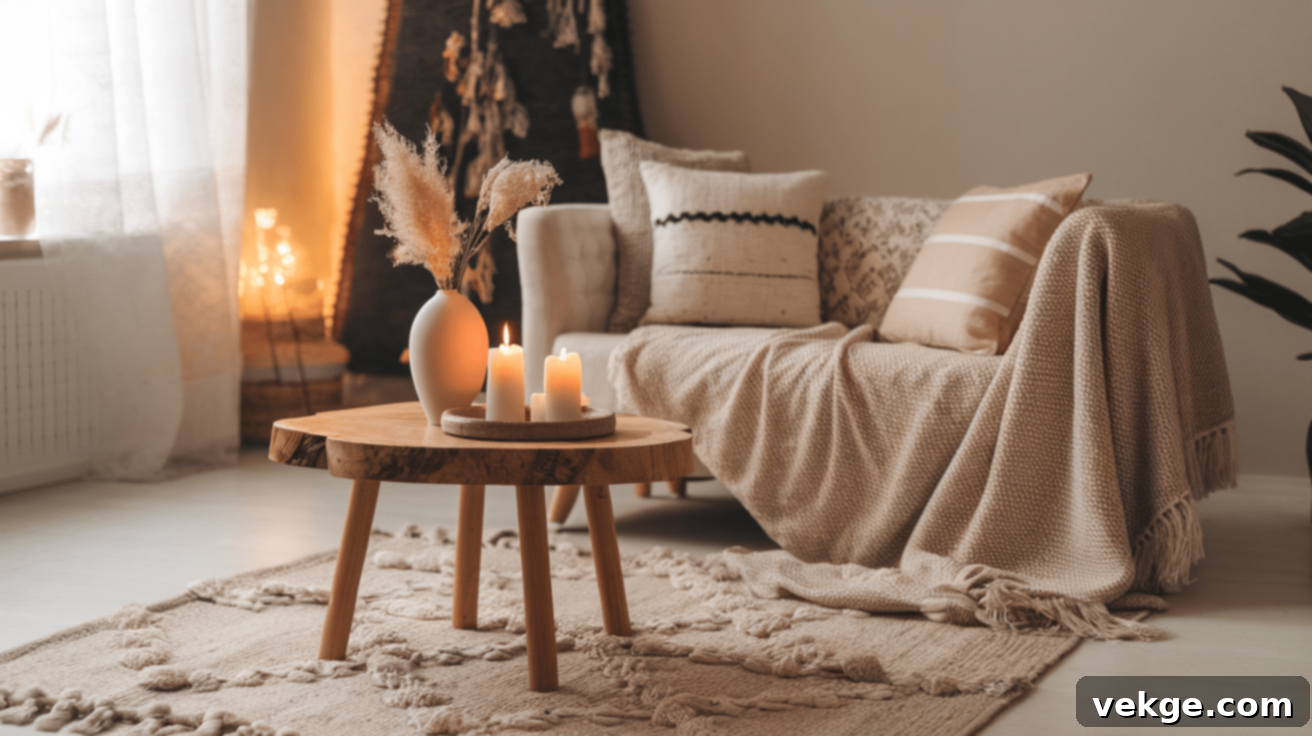
Your living room is often the central gathering place, making it ideal for hygge. Opt for deep, soft seating like a plush sofa or oversized armchairs that invite you to sink in. Layer generously with an abundance of cozy pillows and soft throws in various textures—think faux fur, chunky knits, or soft cotton. Ditch harsh overhead lights in favor of multiple lamps with warm-toned bulbs and strategically placed candles to create a soft, inviting glow.
Incorporate natural materials through wooden coffee tables, woven baskets, and wool or jute rugs underfoot. Arrange furniture to encourage easy conversation and connection, perhaps around a central focal point like a fireplace. Keep a basket of extra blankets nearby for instant comfort, and consider adding a small stack of engaging books or board games to promote shared moments.
Bedroom: Your Personal Hygge Retreat
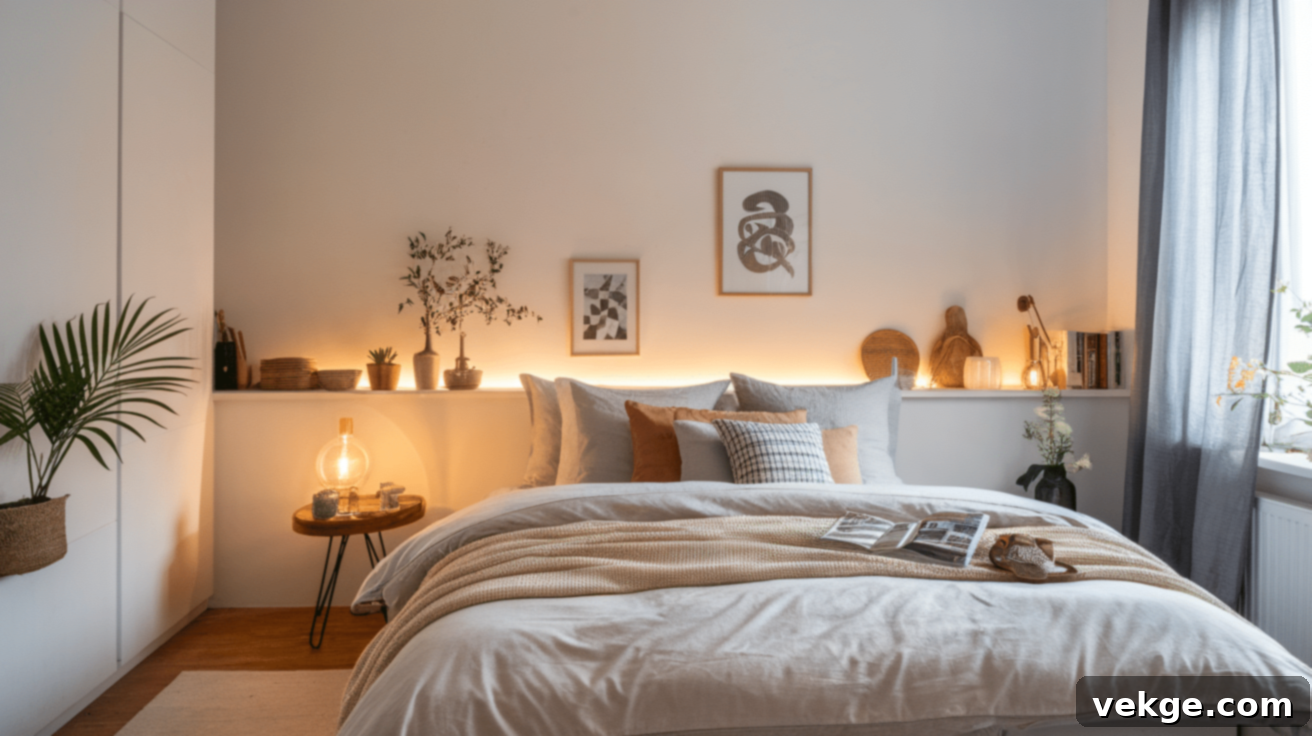
Transform your bedroom into a serene and calm sanctuary designed for ultimate rest and rejuvenation. Start with luxurious, soft bedding made from natural fabrics like linen or organic cotton. Layer blankets of different weights and textures to allow for adjustable comfort throughout the night and across seasons. Instead of bright overhead lights, rely on dimmable bedside lamps with warm bulbs and perhaps a strand of delicate string lights for a gentle, dreamy evening glow.
Prioritize reducing clutter to promote a peaceful mind and enhance restful sleep; consider smart storage solutions for items that don’t contribute to the tranquil atmosphere. If space permits, carve out a small reading nook with a comfortable chair, a soft throw, and a good reading lamp – perfect for quiet moments before bed or lazy weekend mornings.
Dining Room: Fostering Hygge Connections at the Table
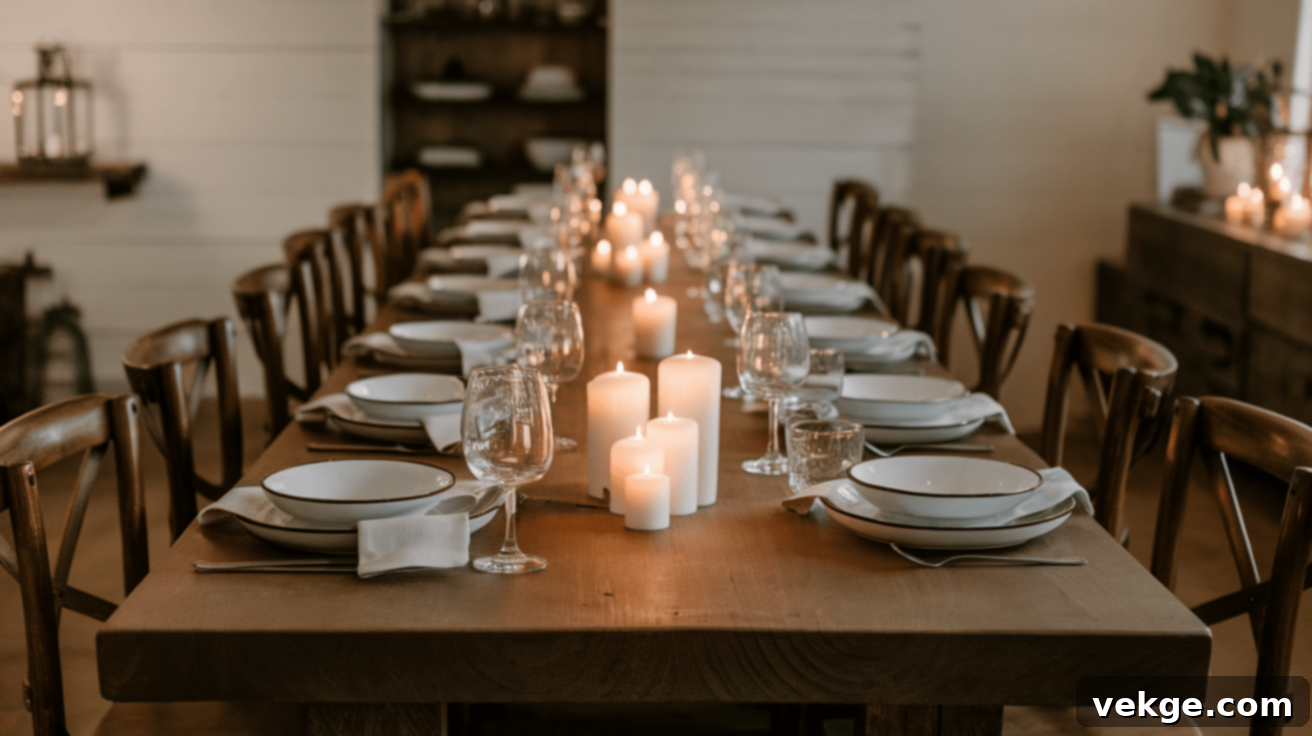
Elevate your dining area into a central hub for meaningful connection and shared meals. Select a sturdy, right-sized wooden table that feels grounded and inviting, paired with comfortable chairs that encourage lingering conversations long after the plates are cleared. During meals, opt for warm, soft lighting from dimmable fixtures or, even better, the ambient glow of candles placed down the center of the table.
Embrace simplicity with natural linen or cotton cloth napkins, basic yet elegant dishware, and perhaps a small vase of fresh flowers. The focus should remain squarely on the food, the company, and the joy of coming together, free from excessive fuss or formality. Create an atmosphere where everyone feels relaxed and encouraged to share stories and laughter.
Home Office: Productive Comfort and Calm
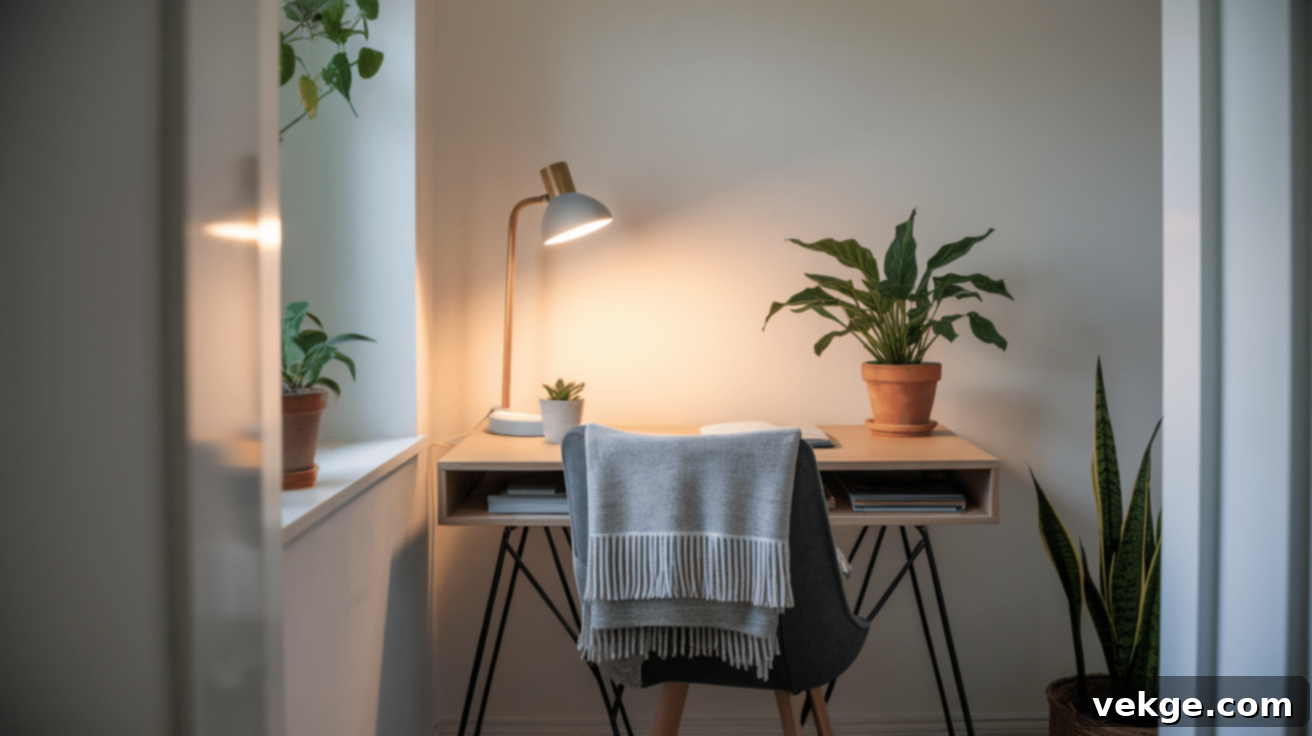
Even your workspace can benefit immensely from a touch of hygge, fostering both productivity and peace. Invest in a truly comfortable chair and a well-designed desk that supports good posture and reduces strain. Supplement your main lighting with a small, adjustable task lamp that provides a warm, focused glow without being harsh. Integrate elements of nature with a few thriving plants or thoughtfully placed wooden accessories.
Keep a soft throw blanket within reach for cooler moments and consider a plush rug underfoot to add warmth and dampen sound. Organize your supplies neatly in natural material containers to minimize visual clutter and stress. A hygge home office is about creating an environment where focus comes easily because you feel supported, comfortable, and calm.
Hygge for Every Season: Year-Round Comfort
While many instinctively associate hygge with the snowy landscapes and dark evenings of winter, this adaptable Danish approach to comfort and well-being works beautifully across all four seasons. By making small, thoughtful adjustments to your materials, lighting, and activities, you can wholeheartedly embrace the cozy and comforting spirit of hygge, no matter what the weather brings outside your window.
Winter Hygge: Embracing the Deepest Coziness
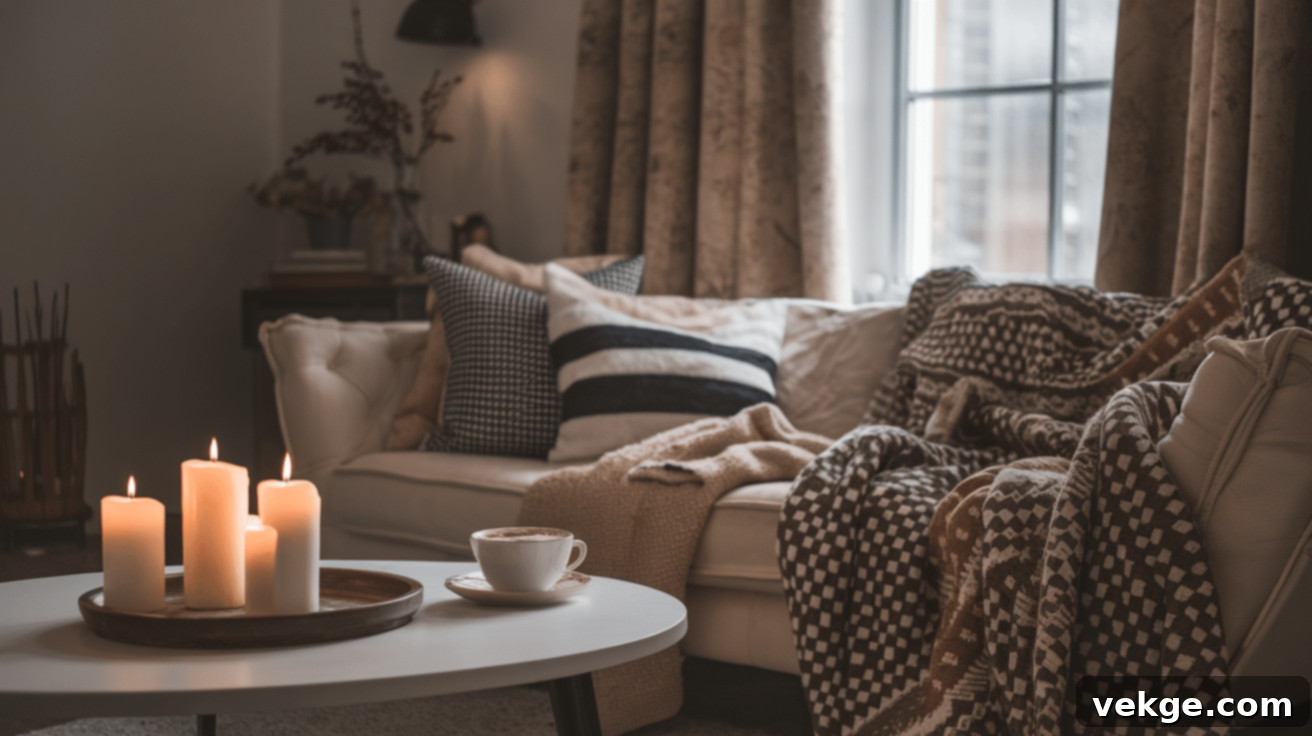
Winter is undeniably when hygge truly comes alive and reigns supreme. This is the season for maximal warmth and snugness. Drape thick wool or fleece blankets over every available surface, and layer plush rugs on floors to add extra warmth and softness. Candles are absolutely essential during winter, providing both a soft, flickering light and a tangible sense of warmth during the long, dark evenings. Create a dedicated hot drink station, stocked with teas, coffee, and hot chocolate ingredients, and keep a generous supply of books, board games, and crafting materials handy for cozy indoor activities. Consider adding heavy, insulated curtains to trap heat and introduce rich textures, further sealing your home against the cold.
Summer Hygge: Light and Airy Comfort
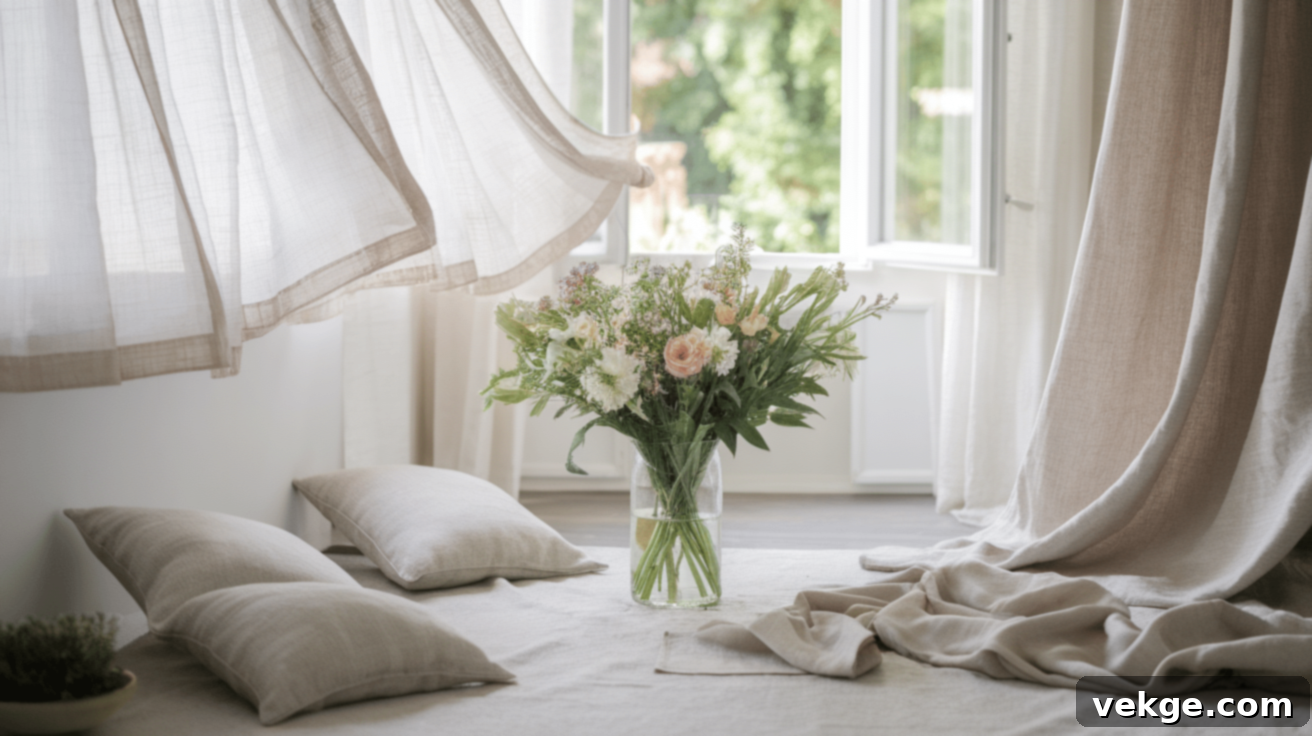
In summer, the focus shifts to creating comfort that is light, airy, and refreshing. Swap out heavy woolens for breathable cotton and linen throws in lighter colors and textures. Update your pillow covers with cooler fabrics and brighter, yet still muted, hues. Open windows wide to invite gentle breezes and hang sheer curtains that dance gracefully with the air currents. Bring the vibrancy of the outdoors in with an abundance of fresh flowers and potted plants. Create inviting outdoor seating areas on your patio or balcony, complete with comfortable cushions and soft lighting for evening enjoyment. Use citrus-scented candles or diffusers to evoke a fresh, invigorating atmosphere, and prioritize enjoying meals al fresco whenever possible.
Fall and Spring Hygge: The Beauty of Transition
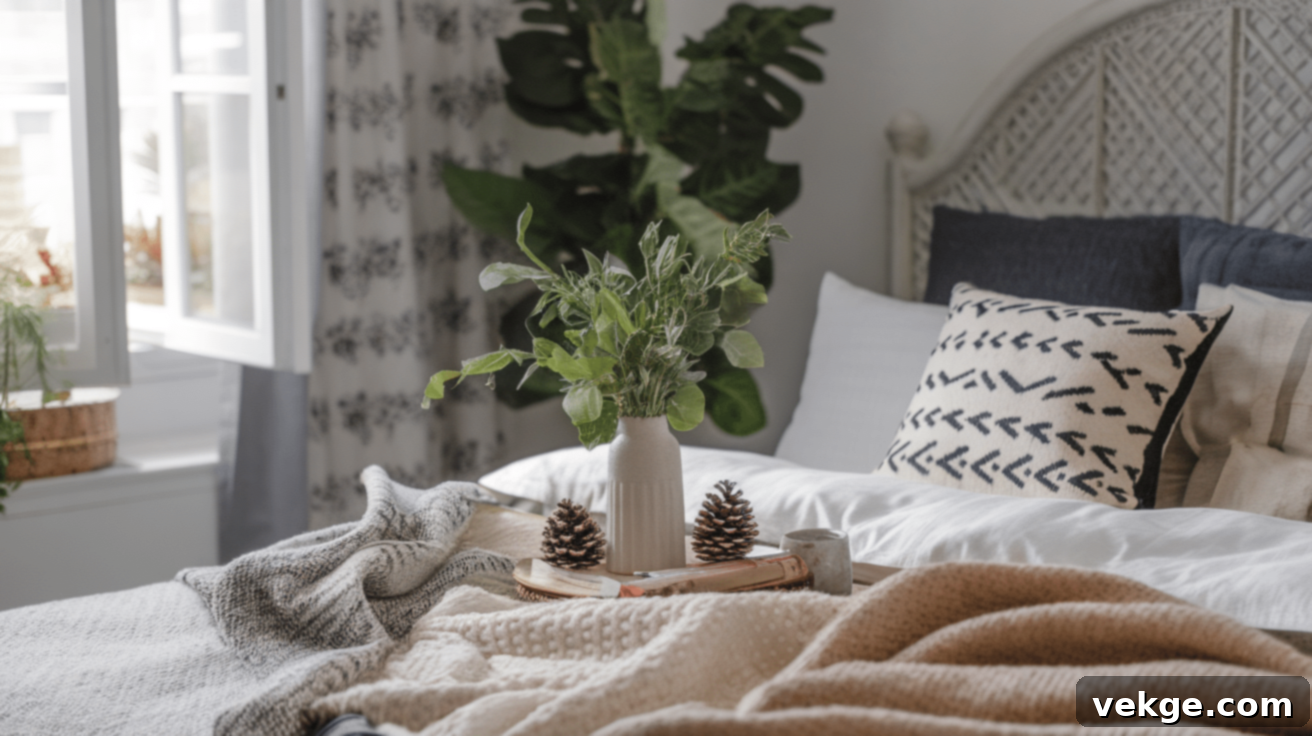
These beautiful transitional seasons require a flexible and adaptable approach to hygge. Keep a mix of both light cotton throws and heavier wool blankets readily available, allowing you to adjust for fluctuating temperatures. Be mindful of changing daylight hours and adjust your lighting accordingly, making the most of natural light during the day and relying on warm lamps and candles as dusk settles. For fall, embrace seasonal decor like decorative pinecones, small gourds, and autumn-hued textiles. In spring, welcome new life with fresh flowers, potted herbs, and an increased presence of vibrant green plants. Both seasons offer perfect opportunities for opening windows on mild days to air out your home, while still reserving the cozy comfort of warm lighting for pleasant evenings indoors.
How to Shop for Hygge-Inspired Products: Mindful Choices
When curating items for a hygge home, the emphasis shifts from impulsive buys to thoughtful acquisitions. Look for quality pieces that genuinely add both comfort and function to your spaces. Prioritize items that feel good to the touch, are built to last, and contribute to a sense of well-being, rather than merely looking aesthetically pleasing for a short time. Shopping for hygge is about investing in timeless comfort and genuine value.
Candles and Lighting: Crafting the Perfect Glow
For candles, opt for simple, unscented varieties in basic, understated holders. Plain white or cream-colored pillar candles, tea lights, or tapers work beautifully and are often more budget-friendly. When selecting light bulbs for your lamps, always choose warm-toned options (between 2700K – 3000K) to create that characteristic soft, inviting glow. Look for lamps with shades made from natural materials like fabric, paper, or woven textures that diffuse light gently. Delicate string lights, especially those with a warm white glow, can be used creatively year-round to add subtle background lighting and a touch of magic to any room, from bedrooms to living areas.
Textiles: Layers of Softness and Texture
When it comes to throws, blankets, and cushions, choose natural fibers that feel exceptionally soft and comforting against your skin. High-quality cotton, wool, linen, or cashmere might represent a slightly higher initial investment, but they offer superior comfort, breathability, and significantly longer durability. Aim to mix different weights and textures to create versatile layers that can be enjoyed across all seasons. For rugs, consider wool blends, which provide both softness underfoot and excellent durability. Stock up on neutral-colored pillow covers in various textures, allowing you to easily refresh your decor and tactile experience without needing to replace entire pillows.
Furniture: Investment in Comfort and Longevity
Prioritize furniture made from real, solid wood over particleboard or plastic alternatives. Pine is often a more budget-friendly option compared to hardwoods like oak or maple, yet still offers natural warmth and character. Explore second-hand shops, antique markets, and online marketplaces for solid wood pieces that can often be acquired at excellent prices and, with a little care, can last for generations. Above all, ensure that any seating you purchase is genuinely comfortable. Don’t hesitate to sit, recline, and truly test chairs and sofas before buying. Sometimes, a single, exceptionally comfortable reading chair paired with an ottoman is a far better investment for hygge living than multiple less comfortable, less inviting pieces.
Before making any purchase for your home, pause and ask yourself a crucial hygge-inspired question: “Will this item genuinely make my home feel more comfortable, welcoming, and conducive to well-being?” If the answer is a resounding yes, then it’s likely a perfect fit for embracing hygge living.
Maintaining the Hygge Atmosphere: Ongoing Nurturing
While creating a hygge space is a delightful journey, maintaining that welcoming and comforting atmosphere requires ongoing, gentle care. The secret lies in striking a harmonious balance between a sense of lived-in comfort and a manageable level of order. This means ensuring your cherished items are cared for and appreciated, without the burden of excessive fuss or stringent perfectionism. Regular, small efforts are key to keeping hygge spaces feeling fresh, inviting, and truly lived-in, contributing to the warm and authentic appeal that makes hygge homes so irresistible.
- Regular, Gentle Cleaning: Maintain cleanliness without resorting to harsh chemicals. Regularly dust surfaces, vacuum rugs and carpets, and wash textiles like throws and bedding as needed to keep them fresh and soft.
- Seasonal Storage: Thoughtfully store seasonal items, such as heavy winter blankets or lighter summer linens, when not in use. This keeps your space uncluttered and makes seasonal transitions feel intentional and refreshing.
- Wood Care: Nourish wooden furniture with a suitable oil or wax once or twice a year to prevent drying out and maintain its natural luster and longevity.
- Textile Maintenance: Wash wool items gently by hand or on a delicate cycle, and always air dry them to help maintain their softness, shape, and cozy texture.
- Candle Care: Replace candles before they burn down too low and consistently clean holders of any wax drips to keep your display looking tidy and safe.
- Rotate and Refresh: Periodically rotate textiles, decorative objects, or even small furniture pieces between rooms. This simple act can give your spaces a fresh look and feel without the need to purchase new items.
Conclusion: Embracing a Lifestyle of Comfort and Connection
The hygge approach to home design offers far more than just a beautiful aesthetic; it provides a profound framework for creating spaces that truly nurture well-being, foster deep comfort, and encourage genuine connection. By thoughtfully focusing on the use of natural materials, cultivating soft and inviting lighting, and layering cozy, tactile textures, you can consciously build rooms that feel like a warm embrace, comfortable to live in and enjoy year-round.
The inherent beauty of hygge lies in its accessibility and its gentle demands. It doesn’t require perfection, nor does it necessitate significant financial investment. Often, the most impactful changes are the simplest: arranging a few flickering candles, draping a beloved soft blanket over a chair, or subtly rearranging seating to encourage conversation. These small, intentional adjustments can swiftly infuse the inimitable feeling of hygge into any home, regardless of size or style.
As you embark on your own hygge journey and experiment with these ideas, you’ll undoubtedly discover what resonates most deeply with your personal space and lifestyle. We are always inspired by how our community brings hygge to life in their homes—we’d love for you to share your photos or explore more inspiring ideas and practical tips in our related posts and guides. Embrace the Danish art of hygge, and transform your home into a sanctuary of warmth, peace, and contentment.
